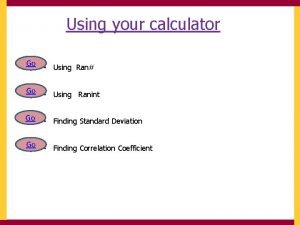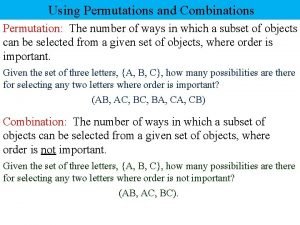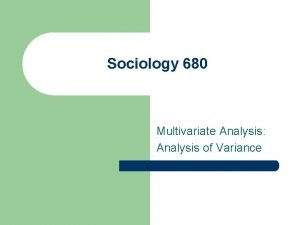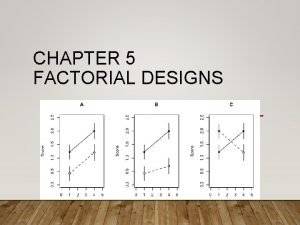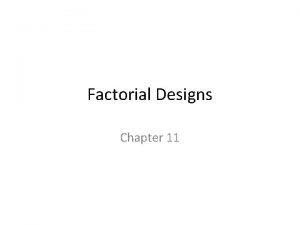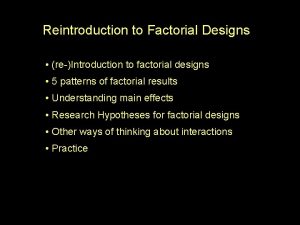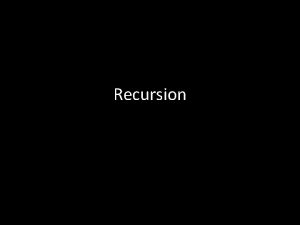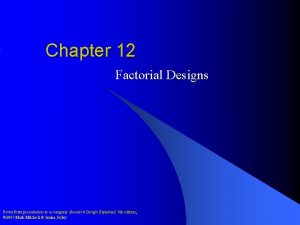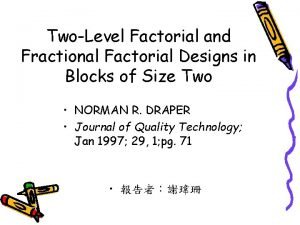Chapter 8 Factorial Designs Power Point presentation to












- Slides: 12

Chapter 8 Factorial Designs Power. Point presentation to accompany Research Design Explained 4 th edition; © 2000 Mark Mitchell & Janina Jolley

The 2 X 2 Factorial Design l l l The two by two yields four (two pairs of) simple main effects Averaging a treatment’s main effects lets you find the overall main effect: The average effect of varying a factor Comparing a factor’s simple main effects lets you find the interaction between two factors *Power. Point presentation to accompany Research Design Explained © 2000 Mark Mitchell & Janina Jolley 4 th edition;

Interactions Are Important: l l l Interesting questions in modern psychology are often questions about interactions External validity questions are questions involving interactions Questions in applied psychology are often questions involving interactions *Power. Point presentation to accompany Research Design Explained © 2000 Mark Mitchell & Janina Jolley 4 th edition;

Potential Results of a 2 X 2 Factorial Experiment l l l A main effect and no interaction Two main effects and An interaction Interaction without main effects One main effect and An interaction No main effects and no interaction *Power. Point presentation to accompany Research Design Explained © 2000 Mark Mitchell & Janina Jolley 4 th edition;

The Mathematics behind an ANOVA table l l l SS effect/df effect= MS for effect Df for main effect = Levels of main effect -1 Df for interaction between two variables = df for 1 st main effect X df for 2 nd main effect Df for error term = Number of participants - total number of groups MS effect / MS error = F The larger F, the more likely the result is to be significant. *Power. Point presentation to accompany Research Design Explained © 2000 Mark Mitchell & Janina Jolley 4 th edition;

Interpreting the Results of a 2 X 2 Experiment l l Main effects without interactions: It all adds Up Interactions: When combining factors leads to effects that appear to differ from the sum of the individual effects *Power. Point presentation to accompany Research Design Explained © 2000 Mark Mitchell & Janina Jolley 4 th edition;

Ordinal Interactions: “True” Interaction or Measurement. Induced Mirage? l l Ordinal interactions may mean that combining treatments multiplies their individual effects Ordinal interactions may be measurement induced mirages *Power. Point presentation to accompany Research Design Explained © 2000 Mark Mitchell & Janina Jolley 4 th edition;

When to Suspect that an Ordinal Interaction May Be a Mirage l When your data may be ordinal. Suspect that your interaction is a mirage if: – Your measure is ordinal, as would be the case if you had ranked data – Ceiling effects appear likely – Floor effects appear likely *Power. Point presentation to accompany Research Design Explained © 2000 Mark Mitchell & Janina Jolley 4 th edition;

Cross-Over (Disordinal) Interactions: When Interactions Really Are Interactions l Cross-over interactions can’t be the result of having ordinal data *Power. Point presentation to accompany Research Design Explained © 2000 Mark Mitchell & Janina Jolley 4 th edition;

Putting the 2 X 2 to Work l l Adding a replication factor to increase generalizability Using an interaction to find an exception to the rule: Looking at a potential moderating factor *Power. Point presentation to accompany Research Design Explained © 2000 Mark Mitchell & Janina Jolley 4 th edition;

The Hybrid Design: A Factorial Design that Allows You to Study Non-Experimental Variables l l Limitation: Can’t make causal statements about the nonexperimental factor Advantages – Increasing generalizability – Studying effects of similarity – Finding an exception to the rule *Power. Point presentation to accompany Research Design Explained © 2000 Mark Mitchell & Janina Jolley 4 th edition;

Concluding Remarks l Factorial experiments allow you to – Look at the effects of more than one factor at a time – Look for interactions, so that you can l l l Find moderating variables Look at the effects of similarity Answer more interesting questions *Power. Point presentation to accompany Research Design Explained © 2000 Mark Mitchell & Janina Jolley 4 th edition;
 Within-subject design example
Within-subject design example Hindi presentation topics
Hindi presentation topics Power point presentation design west vancouver
Power point presentation design west vancouver Active power reactive power apparent power
Active power reactive power apparent power Power bi power point
Power bi power point Point point power
Point point power Chapter 10 qualitative research designs
Chapter 10 qualitative research designs Chapter 10 qualitative research designs author
Chapter 10 qualitative research designs author What are the characteristic of a qualitative research
What are the characteristic of a qualitative research Factorial button on calculator
Factorial button on calculator Number of permutations formula
Number of permutations formula Expericorr design
Expericorr design Factorial anova
Factorial anova









